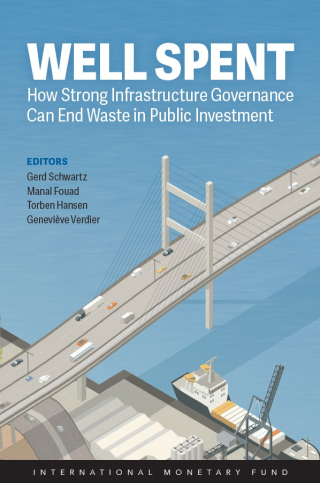
Posted by Richard Allen and Ashni Singh[1]
Efficient and well-integrated planning and budgeting functions are key for building quality infrastructure. Planning functions establish a framework of national, sectoral and subnational government goals, policies, and targets. Budgeting puts these policies into a defined fiscal space and resource envelope, thus allowing policymakers to implement their plans. In many countries, however, strategic planning and budgeting systems are neither efficient nor well integrated. Planning systems are often poorly designed and largely aspirational, while decisions on major infrastructure projects can be dominated by short-term considerations. Budgeting is often separated administratively from the planning process, undermined by weak enforcement of fiscal and budgetary rules, and affected by poor control of budget execution, so that the annual budget lacks credibility.
A chapter[2] in the recently published IMF volume, Well Spent: How Strong Infrastructure Governance Can End Waste in Public Investment, explains what is meant by integrating planning and budgeting functions and why integration matters. At one level “integration” amounts to little more than loose coordination among government ministries and agencies. At the other extreme, it means full integration of planning and budgeting tools and decision-making processes. Between these two extremes exist a wide variety of intermediate approaches. Poorly integrated planning and budgeting functions frequently result in plans for infrastructure investment that are over-ambitious, continuous improvisation in project selection, delays and cost overruns in project implementation, and weak accountability for results.
The authors of the chapter make several critical observations regarding mechanisms that can help achieve better integration of planning and budgeting:
- Effective integration requires the national development plan to be subject to the reality of a fiscal constraint determined by the medium-term fiscal framework.
- The medium-term budget framework (MTBF) is also an important bridge between plans and budgets. Effective integration requires that the medium-term budget framework as well as annual budgets are credible, namely that they both reflect and are executed in line with the plan.
- Public investment programs (PIPs) are another widely used tool to help translate plans into specific projects for inclusion in the budget. PIPs can be useful in providing a bridge between plans and budgets, provided certain conditions are met. For example, projects should only be included if they have been undergone a feasibility study and cost-benefit appraisal and have been selected for inclusion in the MTBF. Projections of project costs should be realistic and include estimates of the recurrent costs of building infrastructure (e.g., equipping and staffing a hospital or university).
The authors of the chapter carried out a survey of 218 countries and independent territories. The survey found that:
- Only around one-third of countries have in place a multiyear rolling PIP comprising a list of the infrastructure projects that a country wants to implement to meet its strategic planning objectives. Relatively few development plans, however, include specific estimates of the cost of implementing the plan.
- Of the 218 countries surveyed, 37 percent have a combined ministry responsible for planning and budget, 49 percent have separate planning and budgeting ministries (or planning commissions), and 15 percent have no central level planning authority. The survey shows organizational arrangements are fluid and subject to political economy considerations. Many countries have changed their organizational arrangements for planning and budgeting several times in recent decades.
Other important conclusions of the chapter are as follows:
- Planning functions have evolved over many years, and continue to evolve, since the classic Soviet model originating in the 1920s and French “dirigiste” planning in the immediate post-World War II period. By the late 1960s development planning had spread to most developing countries as well as to many emerging markets and advanced economies. Budgeting functions similarly have been in a continuous state of evolution since the early 20th
- Planning and budgeting functions are based on fundamentally different objectives, approaches and skills. It is much more important that these functions are carried out efficiently and effectively than that they take on a specific organizational form, for which (as the survey demonstrates) solutions are country dependent and determined by political economy factors.
- Countries could consider some relatively simple reforms to better integrate their planning and budgeting functions. For example, the time horizon for national development plans and medium-term budget frameworks (often different) can be aligned, and a common methodology employed both for classifying public infrastructure in the budget and plan and for measuring and monitoring performance and results.
- The establishment of semi-autonomous planning agencies in some countries has helped mitigate the influence of the electoral cycle on infrastructure decisions. Additionally, the establishment of infrastructure delivery units at the center of government, such as in the offices of the president or prime minister, can help track strategically important investment projects and ensure remedial action if projects go off track or underperform.
- Some of these entities are designed to provide strategic oversight of infrastructure planning, others to deliver projects and/or technical services to line ministries on the appraisal, selection, financing and monitoring of projects. Examples include Infrastructure Australia, the UK’s National Infrastructure Commission, PEMANDU in Malaysia and delivery units in countries such as Brazil and Mexico.
[1] Fiscal Affairs Department, IMF.
[2] Chapter 12 on “Integrating Infrastructure Planning and Budgeting” by Richard Allen, Mary Betley, Carolina Renteria, and Ashni Singh.
Note: The posts on the IMF PFM Blog should not be reported as representing the views of the IMF. The views expressed are those of the authors and do not necessarily represent those of the IMF or IMF policy.





